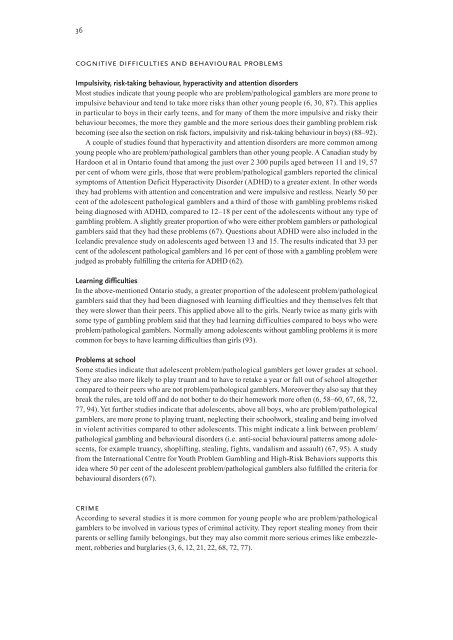Gambling Among Young People, 837 kB
Gambling Among Young People, 837 kB
Gambling Among Young People, 837 kB
You also want an ePaper? Increase the reach of your titles
YUMPU automatically turns print PDFs into web optimized ePapers that Google loves.
36<br />
cognitive difficulties and behavioural problems<br />
Impulsivity, risk-taking behaviour, hyperactivity and attention disorders<br />
Most studies indicate that young people who are problem/pathological gamblers are more prone to<br />
impulsive behaviour and tend to take more risks than other young people (6, 30, 87). This applies<br />
in particular to boys in their early teens, and for many of them the more impulsive and risky their<br />
behaviour becomes, the more they gamble and the more serious does their gambling problem risk<br />
becoming (see also the section on risk factors, impulsivity and risk-taking behaviour in boys) (88–92).<br />
A couple of studies found that hyperactivity and attention disorders are more common among<br />
young people who are problem/pathological gamblers than other young people. A Canadian study by<br />
Hardoon et al in Ontario found that among the just over 2 300 pupils aged between 11 and 19, 57<br />
per cent of whom were girls, those that were problem/pathological gamblers reported the clinical<br />
symptoms of Attention Deficit Hyperactivity Disorder (ADHD) to a greater extent. In other words<br />
they had problems with attention and concentration and were impulsive and restless. Nearly 50 per<br />
cent of the adolescent pathological gamblers and a third of those with gambling problems risked<br />
being diagnosed with ADHD, compared to 12–18 per cent of the adolescents without any type of<br />
gambling problem. A slightly greater proportion of who were either problem gamblers or pathological<br />
gamblers said that they had these problems (67). Questions about ADHD were also included in the<br />
Icelandic prevalence study on adolescents aged between 13 and 15. The results indicated that 33 per<br />
cent of the adolescent pathological gamblers and 16 per cent of those with a gambling problem were<br />
judged as probably fulfilling the criteria for ADHD (62).<br />
Learning difficulties<br />
In the above-mentioned Ontario study, a greater proportion of the adolescent problem/pathological<br />
gamblers said that they had been diagnosed with learning difficulties and they themselves felt that<br />
they were slower than their peers. This applied above all to the girls. Nearly twice as many girls with<br />
some type of gambling problem said that they had learning difficulties compared to boys who were<br />
problem/pathological gamblers. Normally among adolescents without gambling problems it is more<br />
common for boys to have learning difficulties than girls (93).<br />
Problems at school<br />
Some studies indicate that adolescent problem/pathological gamblers get lower grades at school.<br />
They are also more likely to play truant and to have to retake a year or fall out of school altogether<br />
compared to their peers who are not problem/pathological gamblers. Moreover they also say that they<br />
break the rules, are told off and do not bother to do their homework more often (6, 58–60, 67, 68, 72,<br />
77, 94). Yet further studies indicate that adolescents, above all boys, who are problem/pathological<br />
gamblers, are more prone to playing truant, neglecting their schoolwork, stealing and being involved<br />
in violent activities compared to other adolescents. This might indicate a link between problem/<br />
pathological gambling and behavioural disorders (i.e. anti-social behavioural patterns among adolescents,<br />
for example truancy, shoplifting, stealing, fights, vandalism and assault) (67, 95). A study<br />
from the International Centre for Youth Problem <strong>Gambling</strong> and High-Risk Behaviors supports this<br />
idea where 50 per cent of the adolescent problem/pathological gamblers also fulfilled the criteria for<br />
behavioural disorders (67).<br />
crime<br />
According to several studies it is more common for young people who are problem/pathological<br />
gamblers to be involved in various types of criminal activity. They report stealing money from their<br />
parents or selling family belongings, but they may also commit more serious crimes like embezzlement,<br />
robberies and burglaries (3, 6, 12, 21, 22, 68, 72, 77).

















